The Mediating Role of Organizational Commitment between Organizational Justice and Job Performance
DOI:
https://doi.org/10.35945/gb.2025.19.007Keywords:
Organizational commitment, organizational justice, job performance, banksAbstract
The purpose of this study is to assess the mediating role of organizational commitment (OC) between organizational justice (OJ) and job performance (JP). The data was collected from 281 employees using a questionnaire approach. The data analysis used Smarts PLS for assessing the measurement and structure models. The results indicated that organizational commitment mediated the relationship between organizational justice and job performance. The results also showed that OJ has a significant impact on OC and JP, and OC significantly impacts JP.
Managers must be familiar with the essential rules to improve job performance, organizational commitment, and organizational justice while also considering proper conduct. Furthermore, the necessary facilities for promoting professional advancement and training should be established to bolster banks’ current and future demands. The paper elucidates the conclusions and their limitations while also proposing avenues for further research. This study enhances the theoretical framework within organizational theory, organizational behavior, and psychological research, particularly concerning the Iraqi banking sector. However, the study advises banking industry managers to provide fairness and justice in the evaluation processes to improve employee commitment.
Keywords: Organizational commitment, organizational justice, job performance, banks.
Introduction
Unlike in previous eras, human resources are perceived as essential to business efficiency.[1] In the past few years, academicians have debated the strategic significance of human resources (HR) in a world that is dominated by intellectual capital. The new narrative contradicts several study findings indicating that businesses frequently substitute human resources with alternative elements of production when expedient.[2] In most instances, human resources are perceived as a cost that should be reduced, particularly during challenging periods.[3] However, emerging trends provide some encouraging indications that a significant portion of this is undergoing rapid change. HR has transitioned from a cost center to a profit center. In specific sectors, such as technology, banking, services, and knowledge-based work systems, it is the sole primary resource, with others considered secondary.[4] The resource-based perspective posits that the organization’s strategic value is significantly influenced by its knowledge, skills, and abilities, making it unique.[5] Nowadays, organizations consider human resources essential for their continued operation. Consequently, they value their perceptions highly and respect their opinions.[6] Consequently, addressing the factors potentially affecting employees’ perceptions is essential. OJ and OC are two examples of such factors. OJ refers to individuals’ views of fairness in their treatment inside an organization. It is often examined to determine its impact on elements influencing organizational performance, such as OC.[7]
Practitioners and scholars have paid more attention to the concept of justice and process in the workplace. The Staff will express their appreciation when they feel fairness exists in their workplace. HR managers are mainly concerned with the perception of justice, impartial organizational processes, and process impartiality.[8] It is frequently held that securing fair procedures within organizational justice frameworks can enhance employee commitment, productivity, and performance.[9] High job performance is predicated on equitable organizational practices, which include essential elements such as distributive, procedural, and interactional justice.[10] This study defines organizational justice as fair job duties at all organizational levels that are acceptable to all individuals. Employees may perceive these behaviors in terms of equity and organizational justice. Consequently, this study examines organizational justice as a critical prerequisite to assessing its influence on OC.
Several studies have extensively examined organizational commitment.[11],[12] The extensive literature on organizational commitment indicates that it can lead to positive results for both employees and the organizations, including enhanced job performance, productivity, and commitment.[13],[14],[15] Consequently, organizations must prioritize organizational commitment as a significant individual concern, as it results in favorable outcomes in the workplace. However, several previous studies examined the Affective organizational commitment, such as,[16],[17],[18] and limited studies examined the overall organizational commitment,[19] particularly in Iraq. The purpose of this study is to find the impact of OJ on JP and the mediating role of OC.
1. Literature Review
1.1. Social exchange theory
“Social exchange theory”, proposed by Blau in 1964,[20] offers a broad conceptual framework that justice researchers utilize to clarify the influence of individuals’ understanding of justice on JP, commitment, and other results at work. The concept of social exchange perception, initially formulated by Gouldner (1960)[21] and Blau (1964),[22] is the dominant framework used to elucidate the interactions between an organization and its staff. Wayne et al. (2002),[23] establish that workers’ favorable emotions are contingent upon their assessment of the company’s level of investment in them. This concept aligns with the principles of social exchange theory, which posits that exchanges are based on voluntary behaviors rather than formal contracts, in contrast to economic exchanges.[24] Gouldner (1960)[25] defines social exchange as a form of mutually satisfying interaction between both parties, characterized by the development of reciprocal behavior guided by a widely accepted moral standard. In this form of reciprocity, the exchange of reciprocal advantages, namely psychological benefits, helps to uphold a stable social order.[26] Put simply, when an organization shows kindness towards an employee, it develops a sense of duty for the worker to reciprocate with a positive action.[27],[28] Greenberg (1990)[29] suggests that justice can explain several organizational characteristics, such as attitudes and behavior. Within the corporate setting, justice is seen as a significant catalyst for trade or reciprocity. The employee’s thoughts of justice directly influence the quality of the link between them and the workplace. Based on the principles of reciprocity, individuals see the way they are viewed by other social entities as either positive or negative.[30] The “Social exchange theory” posits that by fulfilling individual’s emotional and social needs, organizations may enhance individual commitment to the organization’s purposes, hence resulting in improved job performance.[31]
1.2 Organizational justice
“Organizational justice” refers to workers’ subjective evaluation of the fairness of their treatment inside the workplace. It is commonly investigated to determine its impact on other aspects that influence organizational performance, such as “organizational commitment and job satisfaction”.[32] According to Greenberg (2001),[33] justice in the workplace is related to positive and negative individual behaviours. Individuals assess the level of fairness in the operations and gains of organizations based on the effort they put in.[34] Within organizations, people regularly compare and evaluate themselves in relation to their colleagues. Therefore, the attitudes of these employees are formed based on their opinions of justice.[35],[36] Organizational justice is the beliefs and behaviors that determine whether individuals feel they have been treated fairly and equitably in terms of rewards in their employment. It also involves examining how these perceptions affect other results.[37] According to scholars Greenberg and Colquitt (2013),[38] when an employer treats its staff members fairly and is seen as fair by staff members, it increases the possibility of staff engaging in productive conduct that ultimately benefits the workplace.
“Equity theory”[39] and “Social Exchange Theory (SET)” (Blau, 1964)[40] propose that individuals evaluate the worth of their association with an organization, taking into account the difficulties and advantages involved. This evaluation is influenced by the pay that they get from their job.
There are different perspectives on the dimensions of organizational justice. Some argue that it has three types (“distributive, procedural and interactional”),[41] while others, such as Bies (2001)[42] and Colquitt (2001),[43] propose a fourth dimension called informational justice. Distributive justice is the subjective assessment of resource allocation by individuals in relation to their anticipated contributions and the outcomes they receive.[44] Procedural justice is the concept of fairness that staff members perceive in accordance with the workplace policies and procedures.[45] Interactional justice is the term used to describe the degree of equity that staff members perceive in their interpersonal interactions within the workplace.[46]
Also, there is no broad agreement regarding organizational justice as a holistic or multidimensional construct. Previous studies examined organizational justice as a holistic construct,[47],[48],[49],[50],[51] based on the fairness heuristic theory, people in the workplace attend to overall justice besides the dimensions of justice.[52] Aryee et al. (2015)[53] maintained that justice could describe “the depth and richness” of individuals’ holistic justice experiences, which kinds of justice may not fully represent. They discovered that justice positively correlates with satisfaction and trust in the workplace. Jones and Martens (2009)[54] identified that justice is distinct from four categories of organizational justice “(distributive, procedural, interpersonal, and informational)” and is closely associated with emotional and organizational commitment.
In conclusion, there is no consensus on whether justice is a multi-faceted or holistic concept. This paper’s premise is based on an adaptation of the justice heuristic theory argument by Lind (2001)[55] and Ambrose and Schminke (2009).[56] According to this theory, people’s perceptions of OJ are based on four different kinds of justice, and how people act and think is more important than any one kind of justice in shaping their overall perceptions of justice. So, rather than concentrating on specific forms of organizational justice, this paper explores how individuals perceive justice in general.
1.3 Organizational commitment
Employee commitment is often seen as a crucial determinant of organizational productivity and performance.[57] O’Reilly and Chatman (1986)[58] indicated that OC constitutes a psychological connection or relationship between a person and the organization. Allen and Meyer (1996)[59] define OC as the psychological bond the staff members have towards an organization, which minimizes their inclination to leave the workplace. Organizational commitment, similar to organizational justice, is built on the social exchange theory, wherein staff members reciprocate favourable experiences from the organization.[60] Employees with a high degree of commitment will probably remain, maintain their association, and support the organization in attaining its objectives.[61] The term of OC has been associated with several characteristics within an organizational context, including OJ,[62] leadership.[63] Organizational commitment pertains to the loyalty of individuals towards their organizations. OC relies on the assessment of an individual’s perception of the quality of psychological contracts.[64] Organizational commitment consists of three main elements: “affective commitment, normative commitment, and continuance commitment”.[65]
Affective commitment pertains to an organizational member’s emotional tie to the organization, namely the degree to which they desire membership and align with its objectives.[66]
Normative commitment pertains to a member’s sense of moral responsibility to the organization, specifically the degree to which they believe they should remain affiliated.[67]
Continuance commitment: pertains to the expenses associated with departing from the organization, encompassing the loss of perceived advantages and the challenges of securing an alternative job.[68] Several previous studies measured the OC as a single construct, such as.[69],[70],[71]
1.4 Job performance
Job performance is a metric utilized in research within occupational environments.[72] Several kinds of research across disciplines, such as HRM, the health area, and industrial-organizational psychology, have investigated the determinants and consequences of employee JP. Job performance is a critical determinant in an organization that motivates all operations towards attaining organizational objectives.[73],[74] Subsequently, studies determined the concept of job performance to comprehend its intrinsic structure,[75] shifting from the prior emphasis on task performance or the adeptness with which individuals in the workplace execute fundamental or technical duties.[76] Research has established that job performance includes not just task performance but also surroundings and counterproductive work behaviour.[77],[78] Performance in the context refers to actions that facilitate achieving an organization’s social, psychological, and organizational objectives within which the technological core operates.[79] The income, career opportunities, psychological requirements, and well-being of individuals are significantly influenced by their job performance.[80] According to Guo et al. (2016),[81] there is a correlation between employees’ levels of alienation and the variety of jobs assigned to them, as well as the social behavior and culture of the business.
1.5 The impact of organizational justice on Job performance
“Organizational justice” has been recognized as a crucial element in driving employee motivation and, thus, may play a significant role in establishing a competitive advantage within the service sector. Research indicates that the lack of justice within an organization may lead to detrimental consequences such as employee fatigue, the expression of negative emotions, inappropriate behavior, and poor performance.[82] Research indicates that a lack of organizational justice in the workplace can lead to undesirable outcomes such as fatigue and an increase in negative emotions and behaviors among employees, including poor performance.[83] Organizational justice is a critical feature inside organizations that significantly influences JP.[84]
Various prior research studies have been undertaken to examine the impact of OJ on performance.[85],[86],[87],[88] Their study findings established that organizational justice exerts a substantial impact on performance. According to Suliman’s and Kathairi’s (2013)[89] study, it was shown that organizational justice does not have a substantial impact on employee performance. Additionally, people in the firm do not see justice as a determining factor for their performance.
H1: OJ has a significant Impact on JP among bank employees.
1.6 The impact of organizational justice on organizational commitment
One of the extensively studied linkages in management literature is the link between organizational justice and organizational commitment within the framework of social exchange theories. Based on SET, the norm of reciprocity suggests that employees are likely to respond to excellent or fair treatment from the organization or its management by demonstrating commitment to the organization.[90] OJ and OC are strongly interconnected and are often seen as indications of a social interaction.[91] Research on organizational justice often aims to determine its effects on other performance-influencing variables, such as employee commitment and work satisfaction, and staff members of the fairness of their treatment inside the organization.[92] It has been recognized as a crucial element in incentivizing individuals to succeed.[93] It may, therefore, be essential in establishing a competitive advantage in the field of service.[94] Consistent with this approach, research has generally shown that there is a positive relationship between organizational justice and organizational commitment.[95],[96],[97]
H2: OJ has a significant Impact on OC among bank employees.
1.7 The impact of organizational commitment on Job Performance
Organizational commitment enhances operations by influencing the work performance of individuals in different sectors.[98] Organizational commitment is a crucial aspect in improving workers’ performance to deliver optimal service in accordance with customers’ needs.[99],[100] Organizational commitment enhances organizations by influencing employees’ job performance at all levels in the finance, insurance, and health sectors.[101],[102] Arasanmi and Krishna (2019)[103] identified organizational commitment as key to increasing staff performance. Considering the fact that employee commitment to the organization correlates with job performance. Researchers have utilized several approaches to demonstrate a relationship between organizational commitment and job performance.[104],[105] Previous research has indicated a negative impact of organizational commitment on job performance.[106],[107]
H3: OC has a significant Impact on OC among bank employees.
1.8 The mediating role of organizational commitment
Individuals who consider decision-making procedures as unjust are anticipated to exhibit diminished organizational commitment and a decrease in their involvement in OC.[108] Organizational commitment mediates the relationship between the work environment and employee retention.[109] According to Swalhi et al. (2017),[110] effective commitment mediated the relationship between organizational justice and work performance among the SMEs. Organizational commitment was examined as a mediator between workplace spirituality and organizational performance, and the result reported that organizational commitment can play an important role as a mediator in the context of several industrial sectors in India.[111] a study conducted among hotel employees and choosing organizational commitment as a mediator between training and development, career development, and work performance, the findings showed organizational commitment significantly mediated the relationship among the mentioned variables.[112]
H4: OC mediates the relationship between OJ and JP among bank employees.
Figure 1. The conceptual model
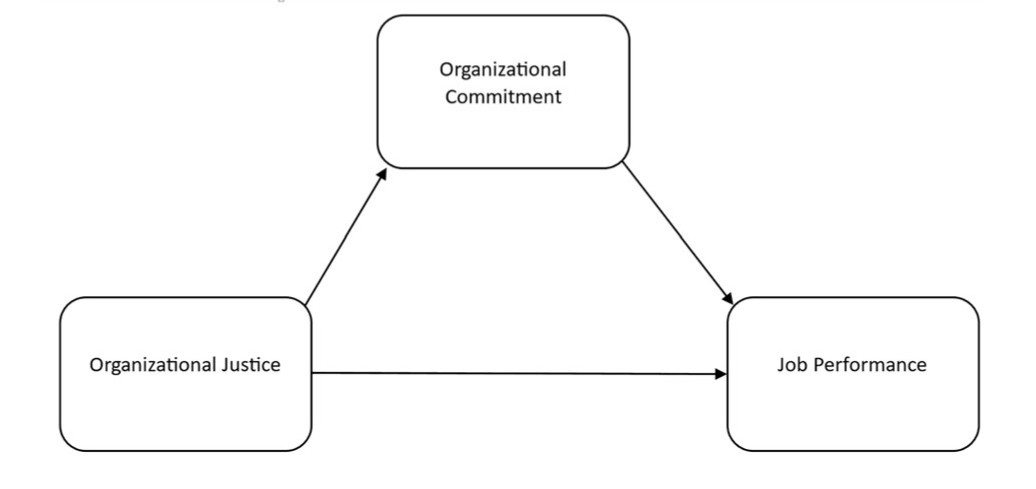
2. Methodology
The study deployed the cross-sectional survey approach to examine the proposed hypotheses. The purpose of this work is to examine the mediating role of OC between OJ and JP in the context of the bank sector. The target population of this study is the employees of private banks located in the capital city of Iraq. Employees from five private banks represented the study sample; before beginning to collect the data, the researcher explained to the human resource department in each bank the purpose of this study and asked them for permission to collect the data. The study used a quantitative approach to collect data from private banks, using a self-administered questionnaire. The bank’s employees from different levels, such as managers, admins of the system and database, network officers, and information security officers, participants in this study. 281 valid questionnaires were analyzed in this study using SPSS and Smart-PLS, which is considered a premier software package for “partial least squares structural equation modeling” (PLS-SEM).[113] PLS-SEM, which emphasizes data prediction and is well-suited for explanatory models, is excellent for investigations that attempt to predict and elucidate outcome constructs.[114] It is also observed that PLS-SEM can be utilized to evaluate causal relationships in investigations characterized by limited sample sizes and insufficient theoretical backing.
According to Herath and Rao (2009),[115] using validated instruments from previous work ensures the reliability of findings. The current study adapted the research items from earlier work to enhance the reliability of the results and reduce the issues related to reliability and validity. Table 1 shows the number of items and sources of each factor. The questionnaire was sent to four experts in the fields of business administration, human resources, and organization theory to assess its structure and questions; based on the experts’ feedback, some items have been reworded and modified. The questionnaire used a five-point Likert scale from “1 (strongly disagree) to 5 (strongly agree)”.
Table 1. Instruments sources

3. Results
The demographic information depicted in Table 2 shows that the majority of employees are men, 73%, and 27% are women, and this reflects the culture of the Governorate. Most of the employees were between 36 and 45 years old, 51%. Most of the employees hold bachelor’s degrees (75%), and working experience shows that most of the employees have between 5 to 10 years of experience (42%). Close to this, 32% have between 11 and 15 years of experience. Table 2 shows all the demographic information in detail.
Table 2. Demographic information
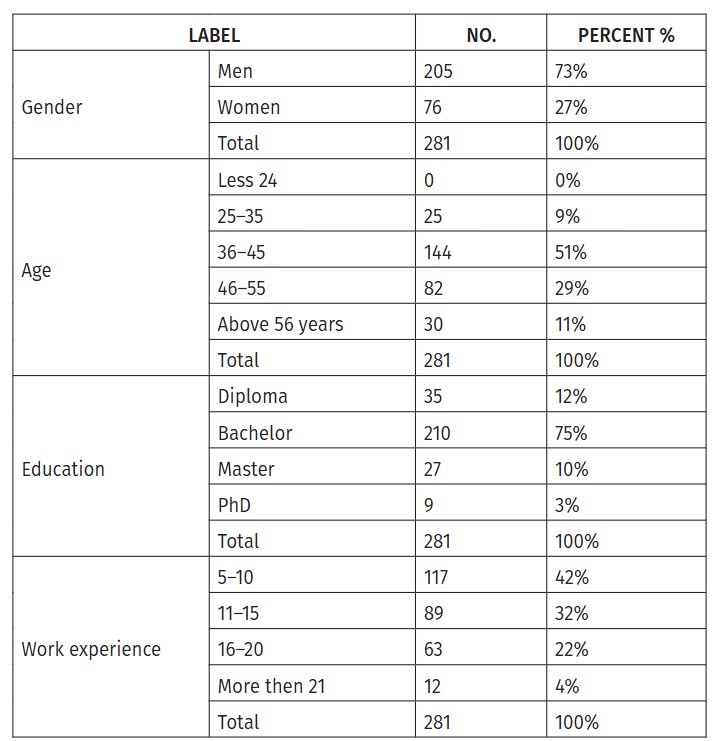
The data analyzed by Smart-PLS in this software should be conducted in two main runs. The first one should be a measurement model to examine reliability, validity, and convergent validity. The outer loading is the first indicator assessed to measure the model’s validity. Hair et al. (2019),[116] indicated that the values of each loading should be 0.708 and above are recommended. The results are shown in Table 3 and Figure 2. All the loadings above 0.708, except JP3, JP4, OC4, and OJ1, were lower than 0.70 and thus removed from the model to enhance the model’s validity.
The reliability is assessed by Cronbach’s alpha and “Composite reliability” (CR) to confirm the internal consistency of each factor. The values should be 0.70 and above (Hair et al., 2019).[117] The values, as shown in Table 3, are all above the recommended value; thus, the model is reliable. The “Average variance extracted” (AVE) is assessed to examine the variance of factor items. The recommended AVE is 0.50 and above, which means that at least the factor explains 50 per cent of the variance, and it is the items. The value of each factor shown in Table 3 is between 0.604 OJ and 0.713 JP; thus, there is no issue with convergent validity.
Table 3. Validity and reliability
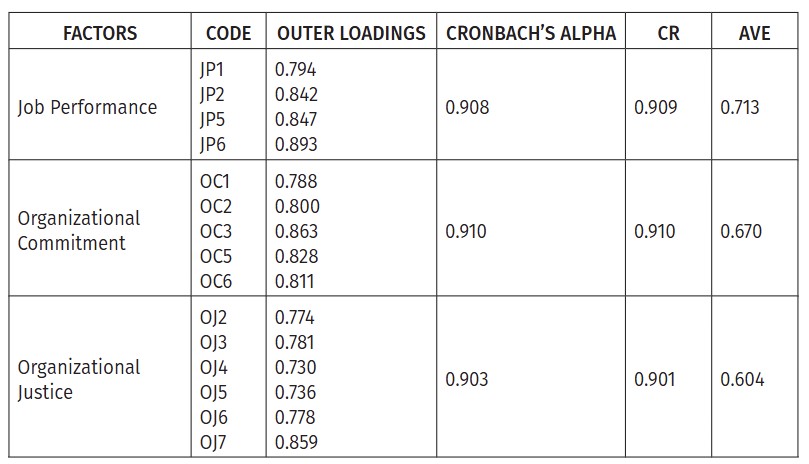
Discriminant validity
The purpose of this step is to measure how empirically each factor is different from another factor in the proposed model. Fornell and Larcker (1981)[118] according to this criterion, each factor AVE should correlate with the same factor higher than another factor. Table 4 shows that each factor correlated with itself higher than others in columns and rows, with the value highlighted in bold font.
Table 4. Fornell-Larcker criterion

Note: OJ: Organizational justice; JP: Job performance; OC: Organizational commitment
Henseler et al. (2015)[119] criticism of the previous methods and replacement with “heterotrait-monotrait” (HTMT) indicated if the HTMT value should be less than 0.9 and if the value is higher than 0.9, there is an issue in discriminant validity based on Table 5, all the HTMT values above 0.9, thus no issue in model discriminant.
Table 5. HTMT
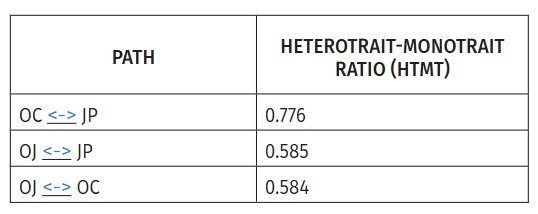
Note: OJ: Organizational justice; JP: Job performance; OC: Organizational commitment
Figure 2. Measurement model
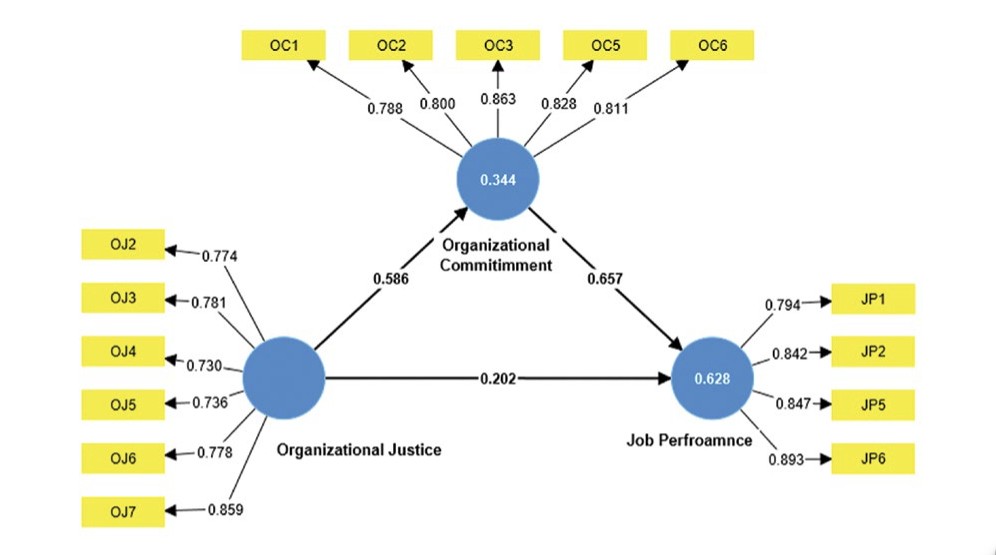
The second main step after assessing the measurement model is to use structural models to examine the proposed hypotheses. The first criterion in this step is to determine the collinearity of the model to ensure there are no biased results in the proposed model by VIF, According to Hair et al. (2019),[120] if the VIF values are above 5, this indicates there are issues in the collinearity among the model factors and the best value of VIF 3 and lower according to Table 6 all the VIF values between 1.662 OJ7 and OC5 3.713 which are less than 5 and most of the VIF value close to 3 and lower thus, there is no issue in model collinearity.
Table 6. VIF
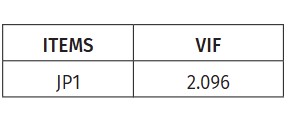
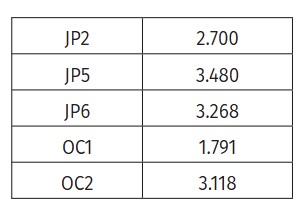
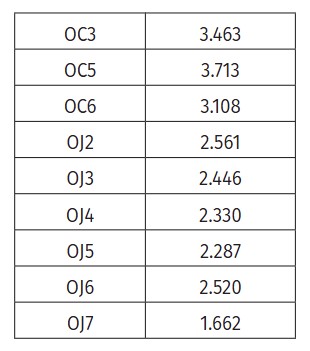
After ensuring there are no issues in the model collinearity, the next step is to assess the coefficient of determination (R2) to measure the variance between the independent variables (IV) and dependent variable (DV) and examine the proposed model’s explanatory power. According to Hair et al. (2019),[121] the R2 values between 0.50 and 0.75 are moderate based on Figure 2 and Figure 3. The R2 of the current model is 0.628; thus, the R2 explains 62% between the IV and DV.
The next criterion is to find the effect size F2 to measure the level of the IV’s effect on DV. According to Cohen (1988),[122] if the F2 is above 0.35, the effect is large; if it is between 0.15 and 0.35, the effect is medium; when the F2 is between 0.02 and 0.15, it is small; and if it is less than 0.02, there is no effect. Based on Table 7, the effect size of OC on JP and OJ on OC is 0.760 and 0.524, respectively, large, and the effect size of OJ on JP is 0.072, which is small.
Table 7. Effect size (F2)
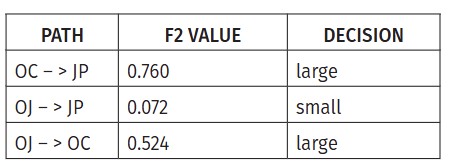
Note: OJ: Organizational Justice; JP: Job Performance; OC: Organizational commitment
The main analysis was run by bootstrapping with a 50000 subsample as recommended by Hair et al. (2019)[123] to reduce the error; the hypothesis results are reported in Table 8 and depicted in Figure 2. The direct effect proposed three hypotheses. All the proposed direct effect hypotheses are supported due to the T-statistics >1.96 and the P-value <0.05. The results indicate that OJ has a positive and significant impact on JP and OC. The p-value is 0.07 and 0.00 <0.05, respectively, and the T-statistics are 2.707 and 10.433 >1.96; thus, H1 and H2 are supported. Similarly, OC has a significant impact on JP with the p-value of 0.00 and the < 0.05 and the 9.312 >1.96; therefore, H3 was supported.
The indirect effect showed that OC mediated the relationship between OJ and JP, with a p-value of 0.00 >0.05 and T-statistics of 6.534 >1.96; thus, H4 was supported.
Table 8. Hypotheses results

Note: OJ: Organizational Justice; JP: Job Performance; OC: Organizational commitment
Figure 3. Structural model

4. Discussion
Dedication is usually inherent among employees in a job. The HR occasionally seeks to assess commitment. The HR typically assesses aspects including motivation, organizational procedures and policies, work environment, and superior-subordinate interactions, while the current study measured the mediating role of OC between the OJ and JP in the context of Iraq.
The current study reported that OJ significantly increased the JP; this result is in line with several previous studies’ results.[124],[125],[126] Organizational justice has a pivotal role in management directives. This indicates that for leaders to effectively realize their goal of exceeding performance standards, it is crucial to cultivate and maintain an objective perception of fairness in workplace processes and treatment among organizational members. This implies that firm personnel must be prepared to exert additional effort to attain the organization’s objectives, provided they cultivate and maintain a long-term perspective. Organizational justice can impact performance; hence, managers’ non-discriminatory attitudes in communication and interaction with employees can enhance work performance. The findings suggest that perceptions of justice influence employees’ propensity to reciprocate with enhanced performance and increased organizational commitment. According to the results presented here, individuals in Iraq place a higher value on the justice they receive from their supervisors and organizational representatives during processes and decision-making. According to the findings, the most important factors in recruiting high-performing and committed workers in Iraq are support, dignity, respect, and honesty.
OJ shown in this study, significantly improved the OC; similar findings were reported in previous research.[127],[128],[129] The results indicate that respondents saw justice as a crucial element of organizational commitment. Ensuring that awards are equitable and transparent enhances the reputation of the business and its executives. A primary cause of discontent in many firms is employees’ perception of inequitable compensation allocation. The perception of equitable procedures reinforces the concept of just organizational practices and value systems. The foundational work suggests that managers should include adequate objectivity in rewards, potentially minimizing managerial discretion to secure employee commitment. This means the employees who recognized higher levels of justice in the workplace were more inclined to indicate increased levels of commitment. When employees see the justice for promotion, salary augmentation, transfer, termination, reward, and punishment as equitable, they are more inclined to willingly accept the judgments, regardless of whether the outcomes are advantageous. Employees who cultivate robust connections with the organization exhibit heightened commitment and concurrently get satisfaction from their profession.
OC has a significant effect on JP. This result is consistent with previous results.[130],[131] The results indicate that employees committed to their organizations demonstrate conduct that benefits the organization. Consequently, ensuring that individuals inside organizations experience a sense of devotion to the organization is essential. This fosters a sense of belonging among employees, motivating them to enhance the organization’s market position. Given that the organization’s greatest asset is its personnel, any actions taken by them for the organization’s advantage would improve its worth. The study suggests that Banks in Iraq should enhance employee commitment. When employees are committed, their performance will improve and increase. The managers must cultivate a culture of good connections in the workplace to increase employee commitment. This will encourage employees’ emotional commitment to their workplace, hence improving their inventive problem-solving capabilities.
The findings indicated a substantial mediating effect of organizational commitment on the connection between organizational justice and job performance among bank staff. The findings of this study are aligned with those of prior research[132],[133],[134] who reported similar findings. This study strengthens the legitimacy of prevalent ideas and certain academic results that employee commitment significantly promotes voluntary activities and fosters good perceptions of organizational justice and performance.[135],[136] Consequently, workplace decision-makers seeking to encourage pro-organizational behaviors among workers should provide cognitive and organizational resources to enhance employee commitment to their positions.
5. Theoretical Contributions and Practical Implications
This study enhances the theoretical framework within HR, organizational behavior, and psychological research, particularly concerning the Iraqi banking sector. The banking industry in Iraq has a significant power gap, characterized by hierarchical organizational structures where authority is predominantly concentrated in the higher echelons. Employees advocate for justice from the upper echelons to the lower levels. Furthermore, incorporating fairness and equality into performance processes within the banking sector is essential for fostering contented and dedicated bank employees and facilitating favorable banking results. This study investigates the mediating role of organizational commitment in the relationship between organizational justice and job performance, contributing significantly to the literature on performance and organizational justice within a unique environment.
The study advises banking industry managers to provide fairness and justice in the evaluation processes to improve employee commitment. To accomplish this, managers should provide sufficient knowledge of the methods and procedures of work performance exercises, enabling employees to comprehend and feel committed to their roles. During the assessment of job performance, the managers or leaders should pay attention to the employee’s respect and dignity; they should ensure justice and equity during the assessment of job performance. Managers must ensure equitable distribution of performance assessment results to foster a sense of responsibility among employees and encourage them to commit more diligently to the bank’s best interests.
6. Limitations and Future Recommendations
The study has several limitations; nonetheless, it also offers recommendations for future research endeavors. The present study was conducted within Iraq’s banking sector, raising concerns regarding generalizability. Consequently, the findings cannot be extrapolated to other sectors. However, this study was performed in the banking industry; thus, the same approach may be utilized in many industries to assess the influence of relationships. Nevertheless, the inclusion of personnel from many industries reveals emerging patterns. The present study examined the influence of organizational commitment as a mediating variable; however, other pertinent aspects, such as organizational citizenship behavior, may affect the link between organizational justice and job performance. It will be intriguing to examine the link using various intervening factors.
Conclusion
This study’s findings provide new perspectives into the interaction between individuals and the workplace, highlighting the roles of justice views, commitments, and performance. The results of the current study and other empirical research confirmed that a high level of justice and commitment leads to an effective strategy for managers to improve job performance and competitive standing. Consequently, the current results reinforce most of the previous work’s conclusion that organizational justice significantly influences individual commitment and performance.
In conclusion, the author advises practitioners and policymakers to focus on behavioral difficulties arising from the intricacies of human and organizational relationships. Establishing equitable and open procedures for resolving human and organizational matters helps enhance employee trust in the organizational procedures and systems.
Bibliography:
- Abdullah, H. O., Al-Abrrow, H. (2023). Impact of perceived organisational justice, support and identity on workplace behaviour through job attitudes: verification in the role of LOC. International Journal of Organizational Analysis, 31(6). Available at: <https://doi.org/10.1108/IJOA-01-2022-3099>;
- Adams, J. S. (1965). Inequity In Social Exchange. Advances in Experimental Social Psychology. Available at: <https://doi.org/10.1016/S0065-2601(08)60108-2>;
- Allen, N. J., Meyer, J. P. (1996). Affective, continuance, and normative commitment to the organization: An examination of construct validity. Journal of Vocational Behavior, 49(3);
- Ambrose, M. L., Schminke, M. (2009). The role of overall justice judgments in organizational justice research: A test of mediation. Journal of Applied Psychology, 94(2). Available at: <https://doi.org/10.1037/a0013203>;
- Arab, H. R., Atan, T. (2018). Organizational justice and work outcomes in the Kurdistan Region of Iraq. Management Decision. Available at: <https://doi.org/10.1108/MD-04-2017-0405>;
- Arasanmi, C. N., Krishna, A. (2019). Employer branding: perceived organisational support and employee retention – the mediating role of organisational commitment. Industrial and Commercial Training, 51(3). Available at: <https://doi.org/10.1108/ICT-10-2018-0086>;
- Aryee, S., Walumbwa, F. O., Mondejar, R., Chu, C. W. L. (2015). Accounting for the Influence of Overall Justice on Job Performance: Integrating Self‐Determination and Social Exchange Theories. Journal of Management Studies, 52(2). Available at: <https://doi.org/10.1111/joms.12067>;
- Begley, T. M., Lee, C., Fang, Y., Li, J. (2002). Power distance as a moderator of the relationship between justice and employee outcomes in a sample of Chinese employees. Journal of Managerial Psychology, 17(8). Available at: <https://doi.org/10.1108/02683940210450493>;
- Bies, R. J. (2001). Interactional (in) justice: The sacred and the profane. Advances in organizational justice/Stanford University Press;
- Blau, P. (1964). Exchange and power in social life. Wiley;
- Boateng, F. D., Hsieh, M. L. (2019). Explaining Job Satisfaction and Commitment Among Prison Officers: The Role of Organizational Justice. Prison Journal, 99(2). Available at: <https://doi.org/10.1177/0032885519825491>;
- Boon, C., Boselie, J. P., Dietz, G. (2005). Commonalities and contradictions in research on human resource management and performance. Human Resource Management, 15(3);
- Brefo-Manuh, A. B., Anlesinya, A. (2023). Performance appraisal justice and work attitudes of health-care workers in Ghana. European Journal of Training and Development, 47(1/2). Available at: <https://doi.org/10.1108/EJTD-02-2021-0027>;
- Brockner, J., Ackerman, G., Greenberg, J., Gelfand, M. J., Francesco, A. M., Chen, Z. X., Leung, K., Bierbrauer, G., Gomez, C., Kirkman, B. L., Shapiro, D. (2001). Culture and Procedural Justice: The Influence of Power Distance on Reactions to Voice. Journal of Experimental Social Psychology, 37(4). Available at: <https://doi.org/10.1006/jesp.2000.1451>;
- Campbell, J. P., McHenry, J. J., Wise, L. L. (1990). Modeling job performance in a population of jobs. Personnel Psychology, 43(2);
- Cohen-Charash, Y., Spector, P. E. (2001). The role of justice in organizations: A meta-analysis. Organizational Behavior and Human Decision Processes, 86(2). Available at: <https://doi.org/10.1006/obhd.2001.2958>;
- Cohen, J. (1988). Statistical power analysis for the behavioral sciences. Academic press;
- Colquitt, J. A., Scott, B. A., Rodell, J. B., Long, D. M., Zapata, C. P., Conlon, D. E., Wesson, M. J. (2013). Justice at the millennium, a decade later: A meta-analytic test of social exchange and affect-based perspectives. Journal of Applied Psychology, 98(2). Available at: <https://doi.org/10.1037/a0031757>;
- Estreder, Y., Tomás, I., Chambel, M. J., Ramos, J. (2019). Psychological contract and attitudinal outcomes: multilevel mediation model. Personnel Review, 48(7). Available at: <https://doi.org/10.1108/PR-07-2018-0237c>;
- Fornell, C., Larcker, D. F. (1981). Evaluating Structural Equation Models with Unobservable Variables and Measurement Error. Journal of Marketing Research, 18(1). Available at: <https://doi.org/10.2307/3151312>;
- Garg, N. (2017). Workplace Spirituality and Organizational Performance in Indian Context: Mediating Effect of Organizational Commitment, Work Motivation and Employee Engagement. South Asian Journal of Human Resources Management, 4(2). Available at: <https://doi.org/10.1177/2322093717736134>;
- Gill, C. (2018). Don’t know, don’t care: An exploration of evidence based knowledge and practice in human resource management. Human Resource Management Review, 28(2). Available at: <https://doi.org/10.1016/j.hrmr.2017.06.001>;
- Gouldner, A. W. (1960). The Norm of Reciprocity: A Preliminary Statement. American Sociological Review, 25(2). Available at: <https://doi.org/10.2307/2092623>;
- Greenberg, J. and Colquitt, J. (2005). Handbook of Organizational Justice (Lawrence E). Mahwah NJ;
- Greenberg, J. (1990). Organizational justice: Yesterday, today, and tomorrow. Journal of Management, 16(2);
- Greenberg, J. (2001). Setting the Justice Agenda: Seven Unanswered Questions about “What, Why, and How”. Journal of Vocational Behavior, 58(2). Available at: <https://doi.org/10.1006/jvbe.2001.1792>;
- Greenberg, J. (2007). The top ten reasons why everyone should know about, and study, organisational justice;
- Greenberg, J., Colquitt, J. A. (2013). Handbook of organizational justice. Psychology Press;
- Guo, W., Dai, R., Yang, J. (2016). The effect of leadership task behavior and relational behavior on job performance: Investigating the moderating role of work alienation. Journal of Service Science and Management, 9(2);
- Hair, J. F., Risher, J. J., Sarstedt, M., Ringle, C. M. (2019). When to use and how to report the results of PLS-SEM. European Business Review, 31(1). Available at: <https://doi.org/10.1108/EBR-11-2018-0203>;
- Henseler, J., Ringle, C. M., Sarstedt, M. (2015). A new criterion for assessing discriminant validity in variance-based structural equation modeling. Journal of the Academy of Marketing Science, 43(1). Available at: <https://doi.org/10.1007/s11747-014-0403-8>;
- Herath, T., Rao, H. R. (2009). Encouraging information security behaviors in organizations: Role of penalties, pressures and perceived effectiveness. Decision Support Systems, 47(2). Available at: <https://doi.org/10.1016/j.dss.2009.02.005>;
- Hosen, S., Hamzah, S. R., Arif Ismail, I., Noormi Alias, S., Faiq Abd Aziz, M., Rahman, M. M. (2024). Training & development, career development, and organizational commitment as the predictor of work performance. Heliyon, 10(1), e23903. Available at: <https://doi.org/10.1016/j.heliyon.2023.e23903>;
- Imamoglu, S. Z., Ince, H., Turkcan, H., Atakay, B. (2019). The Effect of Organizational Justice and Organizational Commitment on Knowledge Sharing and Firm Performance. Procedia Computer Science, 158. Available at: <https://doi.org/10.1016/j.procs.2019.09.129>;
- A.Colquitt. (2001). On the dimensionality of organizational justice: A construct validation of a measure. Journal of Applied Psychology, 68(3);
- Jameel, A. S., Ahmad, A. R., Mousa, T. S. (2020). Organizational justice and job performance of academic staff at public universities in Iraq. Skyline Business Journal, 16(1). Available at: <https://doi.org/10.37383/SBJ160102>;
- Jameel, A. S., Mahmood, Y. N., Jwmaa, S. J. (2020). Organizational Justice and Organizational Commitment among Secondary School teachers. Cihan University-Erbil Journal of Humanities and Social Sciences, 4(1). Available at: <https://doi.org/10.24086/cuejhss.vol4n1y2020.pp1-6c>;
- Jehanzeb, K., Mohanty, J. (2019). The mediating role of organizational commitment between organizational justice and organizational citizenship behavior. Personnel Review, 49(2). Available at: <https://doi.org/10.1108/PR-09-2018-0327>;
- Jiang, Z. (2015). The relationship between justice and commitment: the moderation of trust. Asia-Pacific Journal of Business Administration, 7(1). Available at: <https://doi.org/10.1108/APJBA-02-2014-0022>;
- Jones, D. A., Martens, M. L. (2009). The mediating role of overall fairness and the moderating role of trust certainty in justice–criteria relationships: the formation and use of fairness heuristics in the workplace. Journal of Organizational Behavior, 30(8). Available at: <https://doi.org/10.1002/job.577>;
- Karem, M. A., Jameel, A. S., Ahmad, A. R. (2019). The Impact of Organizational Justice Dimensions on Organizational Commitment among Bank Employees. International Journal of Psychosocial Rehabilitation, 23(02);
- Karem, M. A., Mahmood, Y. N., Jameel, A. S., Ahmad, A. R. (2019). The Effect of Job Satisfaction and Organizational Commitment on Nurses’ Performance. Humanities and Social Sciences Reviews, 7(6). Available at: <https://doi.org/10.18510/hssr.2019.7658>;
- Khaola, P., Coldwell, D. (2019). Explaining how leadership and justice influence employee innovative behaviours. European Journal of Innovation Management, 22(1). Available at: <https://doi.org/10.1108/EJIM-08-2017-0103>;
- Kim, S. H., Laffranchini, G., Jeung, W. (2018). Moderating effect of subordinates’ overall justice in the relationship between supervisors’ overall justice and supervisors’ affective organizational commitment. Journal of Management Development, 37(7). Available at: <https://doi.org/10.1108/JMD-11-2017-0371>;
- Koopmans, L., Bernaards, C., Hildebrandt, V., van Buuren, S., van der Beek, A. J., de Vet, H. C. W. (2012). Development of an individual work performance questionnaire. International Journal of Productivity and Performance Management, 62(1). Available at: <https://doi.org/10.1108/17410401311285273>;
- Kumar Piaralal, N., Mat, N., Kumar Piaralal, S., Awais Bhatti, M. (2014). Human resource management factors and service recovery performance in Malaysian life insurance industry. European Journal of Training and Development, 38(6). Available at: <https://doi.org/10.1108/EJTD-07-2013-0078>;
- Lind, E. A. (2001). Fairness heuristic theory: Justice judgments as pivotal cognitions in organizational relations (C. Stanford University Press, Stanford (ed.)). Advances in organizational justice/Stanford University Press;
- Massoudi, A. H., Jameel, A. S., Ahmad, A. R. (2020). Stimulating Organizational Citizenship Behavior by Applying Organizational Commitment and Satisfaction. International Journal of Social Sciences and Economic Review, 02(02). Available at: <https://doi.org/10.36923/ijsser.v2i2.58>;
- Meyer, J. P., Allen, N. J. (1997). Commitment in the workplace: Theory, research, and application. Sage;
- Meyer, J. P., Allen, N. J., Smith, C. A. (1993). Commitment to organizations and occupations: Extension and test of a three-component conceptualization. Journal of Applied Psychology, 78(4). Available at: <https://doi.org/10.1037/0021-9010.78.4.538>;
- Meyer, J. P., Smith, C. A. (2000). HRM Practices and Organizational Commitment: Test of a Mediation Model. Canadian Journal of Administrative Sciences / Revue Canadienne Des Sciences de l’Administration, 17(4). Available at: <https://doi.org/10.1111/j.1936-4490.2000.tb00231.x>;
- Murdayanti, Y., Indriani, S., Umaimah, W. (2020). Determinants of participative budgeting and its implication on managerial performance. Accounting. Available at: <https://doi.org/10.5267/j.ac.2020.8.020>;
- Nazarian, A., Atkinson, P., Foroudi, P., Edirisinghe, D. (2020). Leaders ororganisations? Acomparison study of factors affecting organisational citizenship behaviour in independent hotels. International Journal of Contemporary Hospitality Management, 32(6). Available at: <https://doi.org/10.1108/IJCHM-05-2019-0463>;
- O’Reilly, C. A., Chatman, J. (1986). Organizational commitment and psychological attachment: The effects of compliance, identification, and internalization on prosocial behavior. Journal of Applied Psychology, 71(3). Available at: <https://doi.org/10.1037/0021-9010.71.3.492>;
- Ohana, M., Meyer, M. (2016). Distributive justice and affective commitment in nonprofit organizations. Employee Relations, 38(6). Available at: <https://doi.org/10.1108/ER-10-2015-0197>;
- Rauf, A., Mahmood, H., Naveed, R. T., Yen, Y. Y. (2024). Modeling cynicism and organizational design on job performance: Mediation and moderation mechanism. Heliyon, 10(11), e32069. Available at: <https://doi.org/10.1016/j.heliyon.2024.e32069>;
- Ringle, C. M., Wende, S., Becker, J.-M. (2015). SmartPLS 3. Boenningstedt: SmartPLS GmbH;
- Rotundo, M., Sackett, P. R. (2002). The relative importance of task, citizenship, and counterproductive performance to global ratings of job performance: A policy-capturing approach. Journal of Applied Psychology, 87(1). Available at: <https://doi.org/10.1037/0021-9010.87.1.66>;
- Salam, A. (2020). Organizational justice as a predictor of organizational citizenship behaviour. International Business Education Journal, 13;
- Sembiring, N., Nimran, U., Astuti, E. S., Utami, H. N. (2020). The effects of emotional intelligence and organizational justice on job satisfaction, caring climate, and criminal investigation officers’ performance. International Journal of Organizational Analysis, 28(5). Available at: <https://doi.org/10.1108/IJOA-10-2019-1908>;
- Snell, S. A., Shadur, M. A., Wright, P. M. (2005). Human Resources Strategy. In The Blackwell Handbook of Strategic Management. Wiley. Available at: <https://doi.org/10.1111/b.9780631218616.2006.00024.x>;
- Suliman, A., Kathairi, M. Al. (2013). Organizational justice, commitment and performance in developing countries: The case of the UAE. Employee Relations, 35(1). Available at: <https://doi.org/10.1108/01425451311279438>;
- Swalhi, A., Zgoulli, S., Hofaidhllaoui, M. (2017). The influence of organizational justice on job performance. Journal of Management Development, 36(4). Available at: <https://doi.org/10.1108/JMD-11-2015-0162>;
- Wayne, S. J., Shore, L. M., Bommer, W. H., Tetrick, L. E. (2002). The role of fair treatment and rewards in perceptions of organizational support and leader-member exchange. Journal of Applied Psychology, 87(3). Available at: <https://doi.org/10.1037/0021-9010.87.3.590>;
- Xia, C., Xu, J., Cheng, J., Hou, Y. (2024). The impact of information overload on the information avoidance of medical staff: The moderating and mediating roles of job performance and time pressure. Computers in Human Behavior Reports, 16, 100474. Available at: <https://doi.org/10.1016/j.chbr.2024.100474>;
- Yiing, L. H., Zaman, K., Ahmad, B., Yiing, L. H., Zaman, K., Ahmad, B. (2009). The moderating effects of organizational culture on the relationships between leadership behaviour and organizational commitment and between organizational commitment and job satisfaction and performance. Available at: <https://doi.org/10.1108/01437730910927106>;
- Zhang, J., Harjan, S. (2021). Investigating the effect of the social customer relationship management (CRM) on customers and financial performance: Evidence from Iraq. International Journal of Research in Business and Social Science (2147-4478), 10(1).
Footnotes
[1] Jehanzeb, K., Mohanty, J. (2019). The mediating role of organizational commitment between organizational justice and organizational citizenship behavior. Personnel Review, 49(2), pp. 445–468.
[2] Snell, S. A., Shadur, M. A., Wright, P. M. (2005). Human Resources Strategy. In The Blackwell Handbook of Strategic Management, Wiley, pp. 631–653.
[3] Gill, C. (2018). Don’t know, don’t care: An exploration of evidence based knowledge and practice in human resource management. Human Resource Management Review, 28(2), pp. 103–115.
[4] Jehanzeb, K., Mohanty, J. (2019). The mediating role of organizational commitment between organizational justice and organizational citizenship behavior. Personnel Review, 49(2), pp. 445–468.
[5] Boon, C., Boselie, J. P., Dietz, G. (2005). Commonalities and contradictions in research on human resource management and performance. Human Resource Management, 15(3), pp. 67–94.
[6] Salam, A. (2020). Organizational justice as a predictor of organizational citizenship behaviour. International Business Education Journal, 13, pp. 29–42.
[7] Cohen-Charash, Y., Spector, P. E. (2001). The role of justice in organizations: A meta-analysis. Organizational Behavior and Human Decision Processes, 86(2), pp. 278–321.
[8] Salam, A. (2020). Organizational justice as a predictor of organizational citizenship behaviour. International Business Education Journal, 13, 29–42.
[9] Ibid.
[10] Greenberg, J., Colquitt, J. A. (2013). Handbook of organizational justice. Psychology Press.
[11] Allen, N. J., Meyer, J. P. (1996). Affective, continuance, and normative commitment to the organization: An examination of construct validity. Journal of Vocational Behavior, 49(3), pp. 252-276.
[12] Meyer, J. P., Smith, C. A. (2000). HRM Practices and Organizational Commitment: Test of a Mediation Model. Canadian Journal of Administrative Sciences / Revue Canadienne Des Sciences de l’Administration, 17(4), pp. 319–331.
[13] Jameel, A. S., Mahmood, Y. N., Jwmaa, S. J. (2020). Organizational Justice and Organizational Commitment among Secondary School teachers. Cihan University-Erbil Journal of Humanities and Social Sciences, 4(1), pp. 1–6. Available: <https://doi.org/10.24086/cuejhss.vol4n1y2020.pp1-6c>.
[14] Meyer, J. P., Allen, N. J. (1997). Commitment in the workplace: Theory, research, and application. Sage.
[15] Ohana, M., Meyer, M. (2016). Distributive justice and affective commitment in nonprofit organizations. Employee Relations, 38(6), pp. 841–858.
[16] Jiang, Z. (2015). The relationship between justice and commitment: the moderation of trust. Asia-Pacific Journal of Business Administration, 7(1), pp. 73–88.
[17] Kim, S. H., Laffranchini, G., Jeung, W. (2018). Moderating effect of subordinates’ overall justice in the relationship between supervisors’ overall justice and supervisors’ affective organizational commitment. Journal of Management Development, 37(7), pp. 526–536.
[18] Swalhi, A., Zgoulli, S., Hofaidhllaoui, M. (2017). The influence of organizational justice on job performance. Journal of Management Development, 36(4), pp. 542–559.
[19] Abdullah, H. O., Al-Abrrow, H. (2023). Impact of perceived organisational justice, support and identity on workplace behaviour through job attitudes: verification in the role of LOC. International Journal of Organizational Analysis, 31(6), pp. 2645–2664.
[20] Blau, P. (1964). Exchange and power in social life. Wiley.
[21] Gouldner, A. W. (1960). The Norm of Reciprocity: A Preliminary Statement. American Sociological Review, 25(2), p. 161.
[22] Blau, P. (1964). Exchange and power in social life. Wiley.
[23] Wayne, S. J., Shore, L. M., Bommer, W. H., Tetrick, L. E. (2002). The role of fair treatment and rewards in perceptions of organizational support and leader-member exchange. Journal of Applied Psychology, 87(3), pp. 590–598.
[24] Blau, P. (1964). Exchange and power in social life. Wiley.
[25] Gouldner, A. W. (1960). The Norm of Reciprocity: A Preliminary Statement. American Sociological Review, 25(2), p. 161.
[26] Jameel, A. S., Ahmad, A. R., Mousa, T. S. (2020). Organizational justice and job performance of academic staff at public universities in Iraq. Skyline Business Journal, 16(1).
[27] Gouldner, A. W. (1960). The Norm of Reciprocity: A Preliminary Statement. American Sociological Review, 25(2), p. 161.
[28] Swalhi, A., Zgoulli, S., Hofaidhllaoui, M. (2017). The influence of organizational justice on job performance. Journal of Management Development, 36(4), pp. 542–559.
[29] Greenberg, J. (1990). Organizational justice: Yesterday, today, and tomorrow. Journal of Management, 16(2), pp. 399–432.
[30] Swalhi, A., Zgoulli, S., Hofaidhllaoui, M. (2017). The influence of organizational justice on job performance. Journal of Management Development, 36(4), pp. 542–559.
[31] Hosen, S., Hamzah, S. R., Arif Ismail, I., Noormi Alias, S., Faiq Abd Aziz, M., Rahman, M. M. (2024). Training & development, career development, and organizational commitment as the predictor of work performance. Heliyon, 10(1), e23903.
[32] Cohen-Charash, Y., Spector, P. E. (2001). The role of justice in organizations: A meta-analysis. Organizational Behavior and Human Decision Processes, 86(2), pp. 278–321.
[33] Greenberg, J. (2001). Setting the Justice Agenda: Seven Unanswered Questions about “What, Why, and How”. Journal of Vocational Behavior, 58(2), pp. 210–219.
[34] Abdullah, H. O., Al-Abrrow, H. (2023). Impact of perceived organisational justice, support and identity on workplace behaviour through job attitudes: verification in the role of LOC. International Journal of Organizational Analysis, 31(6), pp. 2645–2664.
[35] Ibid.
[36] Salam, A. (2020). Organizational justice as a predictor of organizational citizenship behaviour. International Business Education Journal, 13, pp. 29–42.
[37] Ibid.
[38] Greenberg, J., Colquitt, J. A. (2013). Handbook of organizational justice. Psychology Press.
[39] Adams, J. S. (1965). Inequity In Social Exchange. Advances in Experimental Social Psychology.
[40] Blau, P. (1964). Exchange and power in social life. Wiley.
[41] Greenberg, J. (1990). Organizational justice: Yesterday, today, and tomorrow. Journal of Management, 16(2), pp. 399–432.
[42] Bies, R. J. (2001). Interactional (in) justice: The sacred and the profane. Advances in organizational justice/Stanford University Press.
[43] Colquitt, J. A. (2001). On the dimensionality of organizational justice: A construct validation of a measure. Journal of Applied Psychology, 68(3), pp. 386–399.
[44] Greenberg, J. (1990). Organizational justice: Yesterday, today, and tomorrow. Journal of Management, 16(2), pp. 399–432.
[45] Brockner, J., Ackerman, G., Greenberg, J., Gelfand, M. J., Francesco, A. M., Chen, Z. X., Leung, K., Bierbrauer, G., Gomez, C., Kirkman, B. L., Shapiro, D. (2001). Culture and Procedural Justice: The Influence of Power Distance on Reactions to Voice. Journal of Experimental Social Psychology, 37(4), pp. 300–315.
[46] Greenberg, J., Colquitt, J. (2005). Handbook of Organizational Justice (Lawrence E). Mahwah NJ.
[47] Imamoglu, S. Z., Ince, H., Turkcan, H., Atakay, B. (2019). The Effect of Organizational Justice and Organizational Commitment on Knowledge Sharing and Firm Performance. Procedia Computer Science, 158, pp. 899–906.
[48] Jehanzeb, K., Mohanty, J. (2019). The mediating role of organizational commitment between organizational justice and organizational citizenship behavior. Personnel Review, 49(2), pp. 445–468.
[49] Jones, D. A., Martens, M. L. (2009). The mediating role of overall fairness and the moderating role of trust certainty in justice–criteria relationships: the formation and use of fairness heuristics in the workplace. Journal of Organizational Behavior, 30(8), pp. 1025–1051.
[50] Kim, S. H., Laffranchini, G., Jeung, W. (2018). Moderating effect of subordinates’ overall justice in the relationship between supervisors’ overall justice and supervisors’ affective organizational commitment. Journal of Management Development, 37(7), pp. 526–536.
[51] Rauf, A., Mahmood, H., Naveed, R. T., Yen, Y. Y. (2024). Modeling cynicism and organizational design on job performance: Mediation and moderation mechanism. Heliyon, 10(11), e32069.
[52] Lind, E. A. (2001). Fairness heuristic theory: Justice judgments as pivotal cognitions in organizational relations (C. Stanford University Press, Stanford (ed.)). Advances in organizational justice/Stanford University Press.
[53] Aryee, S., Walumbwa, F. O., Mondejar, R., Chu, C. W. L. (2015). Accounting for the Influence of Overall Justice on Job Performance: Integrating Self‐Determination and Social Exchange Theories. Journal of Management Studies, 52(2), pp. 231–252.
[54] Jones, D. A., Martens, M. L. (2009). The mediating role of overall fairness and the moderating role of trust certainty in justice–criteria relationships: the formation and use of fairness heuristics in the workplace. Journal of Organizational Behavior, 30(8).
[55] Lind, E. A. (2001). Fairness heuristic theory: Justice judgments as pivotal cognitions in organizational relations (C. Stanford University Press, Stanford (ed.)). Advances in organizational justice/Stanford University Press.
[56] Ambrose, M. L., Schminke, M. (2009). The role of overall justice judgments in organizational justice research: A test of mediation. Journal of Applied Psychology, 94(2), pp. 491–500.
[57] Meyer, J. P., Allen, N. J., Smith, C. A. (1993). Commitment to organizations and occupations: Extension and test of a three-component conceptualization. Journal of Applied Psychology, 78(4), pp. 538–551.
[58] O’Reilly, C. A., Chatman, J. (1986). Organizational commitment and psychological attachment: The effects of compliance, identification, and internalization on prosocial behavior. Journal of Applied Psychology, 71(3).
[59] Allen, N. J., Meyer, J. P. (1996). Affective, continuance, and normative commitment to the organization: An examination of construct validity. Journal of Vocational Behavior, 49(3), pp. 252-276.
[60] Blau, P. (1964). Exchange and power in social life. Wiley.
[61] Massoudi, A. H., Jameel, A. S., Ahmad, A. R. (2020). Stimulating Organizational Citizenship Behavior by Applying Organizational Commitment and Satisfaction. International Journal of Social Sciences and Economic Review, 02(02), pp. 20–27.
[62] Karem, M. A., Jameel, A. S., Ahmad, A. R. (2019). The Impact of Organizational Justice Dimensions on Organizational Commitment among Bank Employees. International Journal of Psychosocial Rehabilitation, 23(02), pp. 502–513.
[63] Yiing, L. H., Zaman, K., Ahmad, B., Yiing, L. H., Zaman, K., Ahmad, B. (2009). The moderating effects of organizational culture on the relationships between leadership behaviour and organizational commitment and between organizational commitment and job satisfaction and performance.
[64] Abdullah, H. O., Al-Abrrow, H. (2023). Impact of perceived organisational justice, support and identity on workplace behaviour through job attitudes: verification in the role of LOC. International Journal of Organizational Analysis, 31(6), pp. 2645–2664.
[65] Allen, N. J., Meyer, J. P. (1996). Affective, continuance, and normative commitment to the organization: An examination of construct validity. Journal of Vocational Behavior, 49(3), pp. 252-276.
[66] Ibid.
[67] Ibid.
[68] Ibid.
[69] Imamoglu, S. Z., Ince, H., Turkcan, H., Atakay, B. (2019). The Effect of Organizational Justice and Organizational Commitment on Knowledge Sharing and Firm Performance. Procedia Computer Science, 158, pp. 899–906.
[70] Jehanzeb, K., Mohanty, J. (2019). The mediating role of organizational commitment between organizational justice and organizational citizenship behavior. Personnel Review, 49(2), pp. 445–468.
[71] Nazarian, A., Atkinson, P., Foroudi, P., Edirisinghe, D. (2020). Leaders ororganisations? Acomparison study of factors affecting organisational citizenship behaviour in independent hotels. International Journal of Contemporary Hospitality Management, 32(6), pp. 2055–2074.
[72] Koopmans, L., Bernaards, C., Hildebrandt, V., van Buuren, S., van der Beek, A. J., de Vet, H. C. W. (2012). Development of an individual work performance questionnaire. International Journal of Productivity and Performance Management, 62(1), pp. 6–28.
[73] Arab, H. R., Atan, T. (2018). Organizational justice and work outcomes in the Kurdistan Region of Iraq. Management Decision.
[74] Sembiring, N., Nimran, U., Astuti, E. S., Utami, H. N. (2020). The effects of emotional intelligence and organizational justice on job satisfaction, caring climate, and criminal investigation officers’ performance. International Journal of Organizational Analysis, 28(5), pp. 1113–1130.
[75] Swalhi, A., Zgoulli, S., Hofaidhllaoui, M. (2017). The influence of organizational justice on job performance. Journal of Management Development, 36(4), pp. 542–559.
[76] Campbell, J. P., McHenry, J. J., Wise, L. L. (1990). Modeling job performance in a population of jobs. Personnel Psychology, 43(2), pp. 313–575.
[77] Begley, T. M., Lee, C., Fang, Y., Li, J. (2002). Power distance as a moderator of the relationship between justice and employee outcomes in a sample of Chinese employees. Journal of Managerial Psychology, 17(8), pp. 692–711.
[78] Rotundo, M., Sackett, P. R. (2002). The relative importance of task, citizenship, and counterproductive performance to global ratings of job performance: A policy-capturing approach. Journal of Applied Psychology, 87(1), pp. 66–80.
[79] Zhang, J., Harjan, S. (2021). Investigating the effect of the social customer relationship management (CRM) on customers and financial performance: Evidence from Iraq. International Journal of Research in Business and Social Science (2147-4478), 10(1), pp. 235–245.
[80] Xia, C., Xu, J., Cheng, J., Hou, Y. (2024). The impact of information overload on the information avoidance of medical staff: The moderating and mediating roles of job performance and time pressure. Computers in Human Behavior Reports, 16, 100474.
[81] Guo, W., Dai, R., Yang, J. (2016). The effect of leadership task behavior and relational behavior on job performance: Investigating the moderating role of work alienation. Journal of Service Science and Management, 9(2), pp. 97–110.
[82] Greenberg, J. (2007). The top ten reasons why everyone should know about, and study, organisational justice.
[83] Ibid.
[84] Sembiring, N., Nimran, U., Astuti, E. S., Utami, H. N. (2020). The effects of emotional intelligence and organizational justice on job satisfaction, caring climate, and criminal investigation officers’ performance. International Journal of Organizational Analysis, 28(5), pp. 1113–1130.
[85] Arab, H. R., Atan, T. (2018). Organizational justice and work outcomes in the Kurdistan Region of Iraq. Management Decision.
[86] Imamoglu, S. Z., Ince, H., Turkcan, H., Atakay, B. (2019). The Effect of Organizational Justice and Organizational Commitment on Knowledge Sharing and Firm Performance. Procedia Computer Science, 158, pp. 899–906.
[87] Rauf, A., Mahmood, H., Naveed, R. T., Yen, Y. Y. (2024). Modeling cynicism and organizational design on job performance: Mediation and moderation mechanism. Heliyon, 10(11), e32069.
[88] Sembiring, N., Nimran, U., Astuti, E. S., Utami, H. N. (2020). The effects of emotional intelligence and organizational justice on job satisfaction, caring climate, and criminal investigation officers’ performance. International Journal of Organizational Analysis, 28(5), pp. 1113–1130.
[89] Suliman, A., Kathairi, M. Al. (2013). Organizational justice, commitment and performance in developing countries: The case of the UAE. Employee Relations, 35(1), pp. 98–115.
[90] Khaola, P., Coldwell, D. (2019). Explaining how leadership and justice influence employee innovative behaviours. European Journal of Innovation Management, 22(1), pp. 193–212.
[91] Colquitt, J. A., Scott, B. A., Rodell, J. B., Long, D. M., Zapata, C. P., Conlon, D. E., Wesson, M. J. (2013). Justice at the millennium, a decade later: A meta-analytic test of social exchange and affect-based perspectives. Journal of Applied Psychology, 98(2), pp. 199–236.
[92] Cohen-Charash, Y., Spector, P. E. (2001). The role of justice in organizations: A meta-analysis. Organizational Behavior and Human Decision Processes, 86(2), pp. 278–321.
[93] Jameel, A. S., Mahmood, Y. N., Jwmaa, S. J. (2020). Organizational Justice and Organizational Commitment among Secondary School teachers. Cihan University-Erbil Journal of Humanities and Social Sciences, 4(1), pp. 1–6.
[94] Salam, A. (2020). Organizational justice as a predictor of organizational citizenship behaviour. International Business Education Journal, 13, pp. 29–42.
[95] Boateng, F. D., Hsieh, M. L. (2019). Explaining Job Satisfaction and Commitment Among Prison Officers: The Role of Organizational Justice. Prison Journal, 99(2), pp. 172–193.
[96] Estreder, Y., Tomás, I., Chambel, M. J., Ramos, J. (2019). Psychological contract and attitudinal outcomes: multilevel mediation model. Personnel Review, 48(7), pp. 1685–1700.
[97] Imamoglu, S. Z., Ince, H., Turkcan, H., Atakay, B. (2019). The Effect of Organizational Justice and Organizational Commitment on Knowledge Sharing and Firm Performance. Procedia Computer Science, 158, pp. 899–906.
[98] Hosen, S., Hamzah, S. R., Arif Ismail, I., Noormi Alias, S., Faiq Abd Aziz, M., Rahman, M. M. (2024). Training & development, career development, and organizational commitment as the predictor of work performance. Heliyon, 10(1), e23903.
[99] Abdullah, H. O., Al-Abrrow, H. (2023). Impact of perceived organisational justice, support and identity on workplace behaviour through job attitudes: verification in the role of LOC. International Journal of Organizational Analysis, 31(6), pp. 2645–2664.
[100] Karem, M. A., Mahmood, Y. N., Jameel, A. S., Ahmad, A. R. (2019). The Effect of Job Satisfaction and Organizational Commitment on Nurses’ Performance. Humanities and Social Sciences Reviews, 7(6), pp. 332–339.
[101] Hosen, S., Hamzah, S. R., Arif Ismail, I., Noormi Alias, S., Faiq Abd Aziz, M., Rahman, M. M. (2024). Training & development, career development, and organizational commitment as the predictor of work performance. Heliyon, 10(1), e23903.
[102] Kumar Piaralal, N., Mat, N., Kumar Piaralal, S., Awais Bhatti, M. (2014). Human resource management factors and service recovery performance in Malaysian life insurance industry. European Journal of Training and Development, 38(6), pp. 524–552.
[103] Arasanmi, C. N., Krishna, A. (2019). Employer branding: perceived organisational support and employee retention – the mediating role of organisational commitment. Industrial and Commercial Training, 51(3), pp. 174–183.
[104] Hosen, S., Hamzah, S. R., Arif Ismail, I., Noormi Alias, S., Faiq Abd Aziz, M., Rahman, M. M. (2024). Training & development, career development, and organizational commitment as the predictor of work performance. Heliyon, 10(1), e23903.
[105] Swalhi, A., Zgoulli, S., Hofaidhllaoui, M. (2017). The influence of organizational justice on job performance. Journal of Management Development, 36(4), pp. 542–559.
[106] Murdayanti, Y., Indriani, S., Umaimah, W. (2020). Determinants of participative budgeting and its implication on managerial performance. Accounting, pp. 1305–1312
[107] Yiing, L. H., Zaman, K., Ahmad, B., Yiing, L. H., Zaman, K., Ahmad, B. (2009). The moderating effects of organizational culture on the relationships between leadership behaviour and organizational commitment and between organizational commitment and job satisfaction and performance.
[108] Jameel, A. S., Ahmad, A. R., Mousa, T. S. (2020). Organizational justice and job performance of academic staff at public universities in Iraq. Skyline Business Journal, 16(1).
[109] Arasanmi, C. N., Krishna, A. (2019). Employer branding: perceived organisational support and employee retention – the mediating role of organisational commitment. Industrial and Commercial Training, 51(3), pp. 174–183.
[110] Swalhi, A., Zgoulli, S., Hofaidhllaoui, M. (2017). The influence of organizational justice on job performance. Journal of Management Development, 36(4), pp. 542–559.
[111] Garg, N. (2017). Workplace Spirituality and Organizational Performance in Indian Context: Mediating Effect of Organizational Commitment, Work Motivation and Employee Engagement. South Asian Journal of Human Resources Management, 4(2), pp. 191–211.
[112] Hosen, S., Hamzah, S. R., Arif Ismail, I., Noormi Alias, S., Faiq Abd Aziz, M., Rahman, M. M. (2024). Training & development, career development, and organizational commitment as the predictor of work performance. Heliyon, 10(1), e23903.
[113] Ringle, C. M., Wende, S., Becker, J.-M. (2015). SmartPLS 3. Boenningstedt: SmartPLS GmbH.
[114] Hair, J. F., Risher, J. J., Sarstedt, M., Ringle, C. M. (2019). When to use and how to report the results of PLS-SEM. European Business Review, 31(1), pp. 2–24.
[115] Herath, T., Rao, H. R. (2009). Encouraging information security behaviors in organizations: Role of penalties, pressures and perceived effectiveness. Decision Support Systems, 47(2), pp. 154–165.
[116] Hair, J. F., Risher, J. J., Sarstedt, M., Ringle, C. M. (2019). When to use and how to report the results of PLS-SEM. European Business Review, 31(1), pp. 2–24.
[117] Hair, J. F., Risher, J. J., Sarstedt, M., & Ringle, C. M. (2019). When to use and how to report the results of PLS-SEM. European Business Review, 31(1), pp. 2–24.
[118] Fornell, C., Larcker, D. F. (1981). Evaluating Structural Equation Models with Unobservable Variables and Measurement Error. Journal of Marketing Research, 18(1), p. 39.
[119] Henseler, J., Ringle, C. M., Sarstedt, M. (2015). A new criterion for assessing discriminant validity in variance-based structural equation modeling. Journal of the Academy of Marketing Science, 43(1), pp. 115–135.
[120] Hair, J. F., Risher, J. J., Sarstedt, M., Ringle, C. M. (2019). When to use and how to report the results of PLS-SEM. European Business Review, 31(1), pp. 2–24.
[121] Ibid.
[122] Cohen, J. (1988). Statistical power analysis for the behavioral sciences. Academic press.
[123] Hair, J. F., Risher, J. J., Sarstedt, M., Ringle, C. M. (2019). When to use and how to report the results of PLS-SEM. European Business Review, 31(1), pp. 2–24.
[124] Arab, H. R., Atan, T. (2018). Organizational justice and work outcomes in the Kurdistan Region of Iraq. Management Decision.
[125] Imamoglu, S. Z., Ince, H., Turkcan, H., Atakay, B. (2019). The Effect of Organizational Justice and Organizational Commitment on Knowledge Sharing and Firm Performance. Procedia Computer Science, 158, pp. 899–906.
[126] Rauf, A., Mahmood, H., Naveed, R. T., Yen, Y. Y. (2024). Modeling cynicism and organizational design on job performance: Mediation and moderation mechanism. Heliyon, 10(11), e32069.
[127] Boateng, F. D., Hsieh, M. L. (2019). Explaining Job Satisfaction and Commitment Among Prison Officers: The Role of Organizational Justice. Prison Journal, 99(2), pp. 172–193.
[128] Estreder, Y., Tomás, I., Chambel, M. J., Ramos, J. (2019). Psychological contract and attitudinal outcomes: multilevel mediation model. Personnel Review, 48(7), pp. 1685–1700.
[129] Khaola, P., Coldwell, D. (2019). Explaining how leadership and justice influence employee innovative behaviours. European Journal of Innovation Management, 22(1), pp. 193–212.
[130] Hosen, S., Hamzah, S. R., Arif Ismail, I., Noormi Alias, S., Faiq Abd Aziz, M., Rahman, M. M. (2024). Training & development, career development, and organizational commitment as the predictor of work performance. Heliyon, 10(1), e23903.
[131] Imamoglu, S. Z., Ince, H., Turkcan, H., Atakay, B. (2019). The Effect of Organizational Justice and Organizational Commitment on Knowledge Sharing and Firm Performance. Procedia Computer Science, 158, pp. 899–906.
[132] Arasanmi, C. N., Krishna, A. (2019). Employer branding: perceived organisational support and employee retention – the mediating role of organisational commitment. Industrial and Commercial Training, 51(3), pp. 174–183.
[133] Hosen, S., Hamzah, S. R., Arif Ismail, I., Noormi Alias, S., Faiq Abd Aziz, M., Rahman, M. M. (2024). Training & development, career development, and organizational commitment as the predictor of work performance. Heliyon, 10(1), e23903.
[134] Swalhi, A., Zgoulli, S., Hofaidhllaoui, M. (2017). The influence of organizational justice on job performance. Journal of Management Development, 36(4), pp. 542–559.
[135] Begley, T. M., Lee, C., Fang, Y., Li, J. (2002). Power distance as a moderator of the relationship between justice and employee outcomes in a sample of Chinese employees. Journal of Managerial Psychology, 17(8), pp. 692–711.
[136] Brockner, J., Ackerman, G., Greenberg, J., Gelfand, M. J., Francesco, A. M., Chen, Z. X., Leung, K., Bierbrauer, G., Gomez, C., Kirkman, B. L., Shapiro, D. (2001). Culture and Procedural Justice: The Influence of Power Distance on Reactions to Voice. Journal of Experimental Social Psychology, 37(4), pp. 300–315.
Downloads
Downloads
Published
Issue
Section
License

This work is licensed under a Creative Commons Attribution-ShareAlike 4.0 International License.









